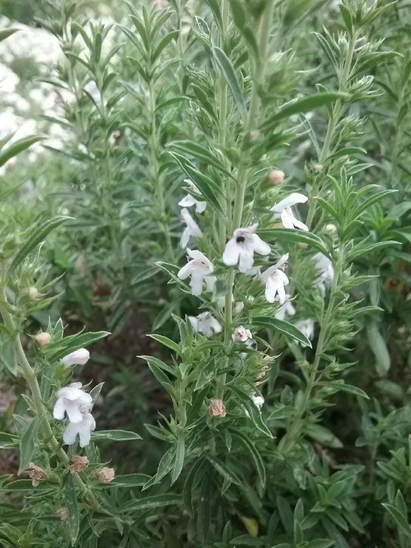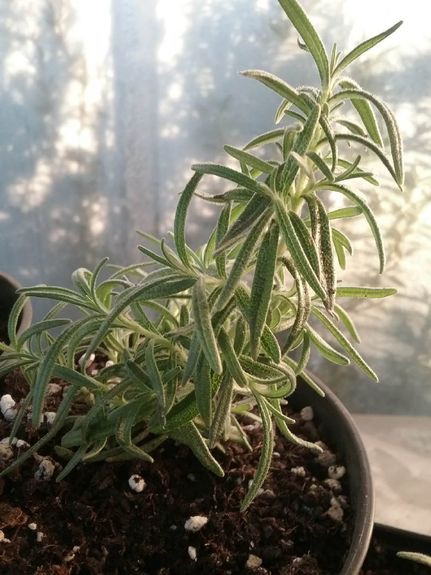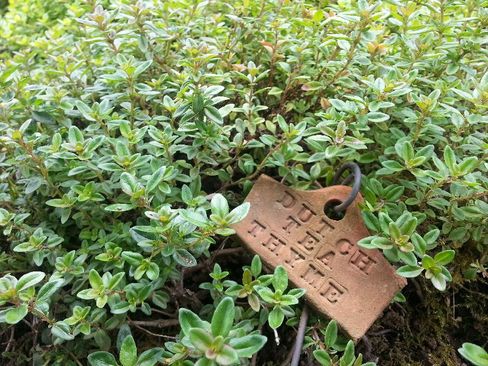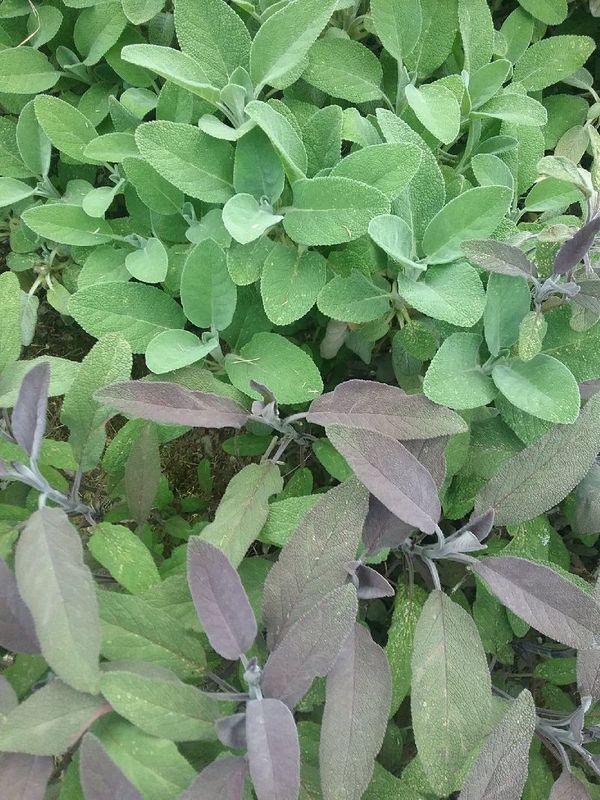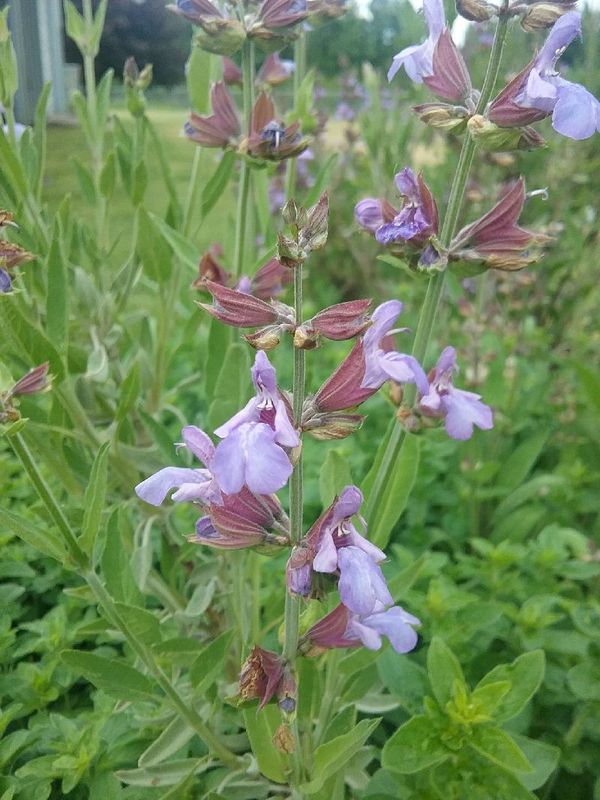And thyme in the breeze.
Bright purple sage flowers so loved by the bees.
Bunches of savory tied up to dry,
These are my favorite perennials under the sky.
Ok, so this may not be the finest poetry but with a nod to Rodgers and Hammerstein, our favorite perennial herbs are indeed rosemary, thyme, sage and winter savory. As many of you know we like perennial plants because they typically require less work than annuals. Not because we are lazy, but because they are durable and seem to take care of themselves which gives us more time for other activities in the garden. All four of these herb plants are native to the Mediterranean region so were well known to the Greeks and Romans whose knowledge of herbs was spread throughout the world.
There are two kinds of savory – summer and winter. Summer savory is an annual that is often preferred by cooks for its flavor which is milder than winter savory. But winter savory maintains its flavor very well when dried, so provides a lasting herbal addition for winter months. Both savory varieties have a spicy, peppery taste and are known throughout Central and Eastern Europe as the “bean” herb. Folk lore suggests that it “expels the wind from the stomach”. It is a component of Herbes de Provence and goes well with meats, potatoes, stews and stronger vegetables. It is often found commercially in sausage. You can find Herbes de Provence and Savory Onion herb blends on the Garden Delights website.
It has been used for over 2,000 years as a healing and household herb as well as for culinary purposes. A simple tea helps soothe the digestive system. A strong infusion makes a good mouthwash. To treat insect bites, bruise some fresh leaves and apply to the bite. Winter savory can be found in toothpastes and soaps.
Savory Herbal Marinade
For Beef:
2 ½ C Red Wine
3/4 C Red Wine Vinegar
1 small onion chopped
2 carrots, diced
1 stalk celery, chopped
2 cloves garlic, sliced
2 bay leaves, broken into pieces
2 tsp each fresh Thyme, Oregano and Winter Savory, coarsely chopped
Salt
Allow meat to marinate overnight or about 12 hours.
For Chicken:
Exchange the red wine for white wine and the red wine vinegar for white wine vinegar. Change the herbs to tarragon, lemon thyme or lemon verbena and savory or any combination of those.
For Pork: add fresh mint to the White Wine Marinade.
Rosemary has a long history of legends and uses of all kinds. It is known as the herb of remembrance and friendship and was associated with many stories of the Christian religion. In Renaissance times it was used as a strewing herb to mask odors and to ward against evil which had a secondary purpose, perhaps not known to all its users, to help prevent the spread of germs and disease. It was often included in the small bouquets (tussie-mussie) that women carried.
Rosemary’s piney fragrance makes it a good addition to potpourri which can serve double duty as an insect repellent. Add some catnip to help ward off mosquitoes or lavender to send moths running. With its strong pungent flavor, rosemary it pairs well with meats and wakes up mild veggies like potatoes (like those rosemary French fries so popular at a local burger joint) and beans. It is easy to dry – place in a paper bag and wait about a week. Be sure to grind the needley leaves before adding to your cooking. Just ask Erin about this, as she found “pine” needles in her food at college. As a vinegar, rosemary is an outstanding addition to any pantry.
Rosemary Vinegar
2 C white vinegar
4-5 small sprigs fresh rosemary
Place rosemary in a clear glass jar, add vinegar and cover with a plastic lid. If a metal lid is used, place some kind of a liner between the lid and jar. Let it sit in a sunny window for about a week or 3-4 weeks in a dark cupboard. Taste and if ready, strain out herbs and store. Makes a tasty salad dressing or marinade.
Thyme likes sun and because of its size does well in a container. The flowers grow in a vertical cluster and are typically pinkish and of course loved by bees. In many Mediterranean countries thyme honey is considered the very best. To keep the plants small bushy mounds, in the spring prune back the stems to about half their length.
Thyme has many uses in cooking in stuffing, hearty soups, all vegetables, marinades, oils and vinegars with a special affinity to fish dishes. Its familiar flavor is found often in French and Italian cuisine. Although the leaves are tiny they pack a powerful flavor and thyme is often a minor ingredient in recipes or our herb blends.
Thyme leaves and flowers contain an oil called thymol which is used commercially in cosmetics and medicines. Pure thymol has been known to have negative side effects, externally and internally, so caution is in order. Tea made from fresh or dried thyme leaves is said to be good for colds and as a gargle for sore throats. It is antiseptic and disinfectant and was used during World War I to treat soldiers’ wounds.
Herbed Croutons
Using a loaf of Italian bread, slice and trim crusts from slices. Cut slices into ½ to 1 inch pieces. Set aside. Melt ½ C butter in skillet. Add ½ teaspoon of each dried herb – thyme, basil and marjoram (or any of your favorite herbs). Add a little onion or garlic power if desired. Sauté bread cubes in hot butter mixture, turning to brown on all sides. Drain on paper towels. Ready for soups or salads.
Sage – Salvia officinalis comes in many different varieties: common garden, purple, variegated, tri-colored, pineapple, big leaf and berggarten for a few. Its leaves are oval shaped with a rough, wooly texture and common sage has a greenish-grey hue. Flowers grow on stalks above the leaves and range in color from pinkish, blue, lavender and purple and are a super pollinator attractant. At the farm we grow berggarten, purple and common sage. We tried pineapple sage, which has beautiful almost tropical looking reddish blooms, but found it too finicky for our area where it might make a nice houseplant. All the sages have the same properties and can be used in cooking and since sage has a long, strong tradition as a healing herb, it is a good addition to any herbal garden.
Sage is typically associated with poultry and is of course a main ingredient in Garden Delights Poultry Blend. It also pairs well with pork and its rich flavor complements many vegetables. When the leaves are dried and ground, it is fluffy and greyish, not like most herbs, but that does not lessen its flavor.
The astringent property of sage has been proven scientifically but over time it has been used by herbalists to help soothe a great many ills.
Healing Herbal Infusions/Tisanes
Drinking teas, while they may contain the same herbs as healing teas, they do not have the same potency. So it is best to make your own more concentrated teas which are infusions or tisanes. Bring 1 pint of water to a full-rolling boil. Remove from burner and add 2 C dried herbs or 4 C fresh herbs. Steep the leaves in the boiling water for about 15 minutes depending or longer for stronger. Strain and drink or gargle about ½ C at a time.
Sage - to soothe sore throats, stifle coughs and treat cold sores. Add a little vinegar and inhale the vapors to help relieve cold symptoms.
Thyme – help treat excessive mucus
Marjoram and lavender – effective gargle
Chamomile, borage flowers, and catnip – to lessen stress, promote calm
Peppermint and echinacea – help remedy headaches
So enjoy these, our favorite perennial herbs!

